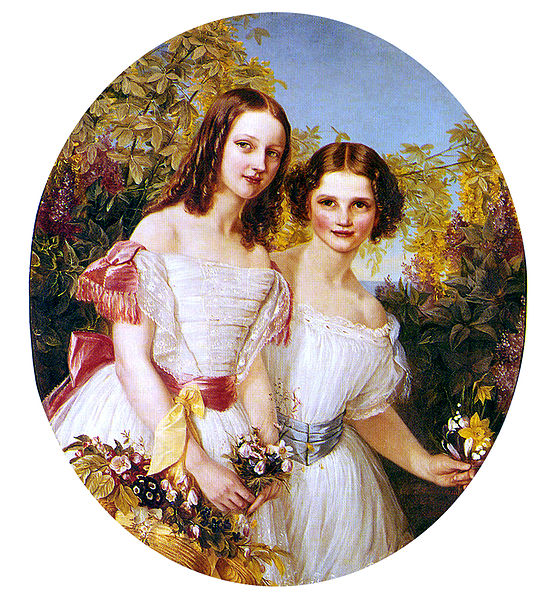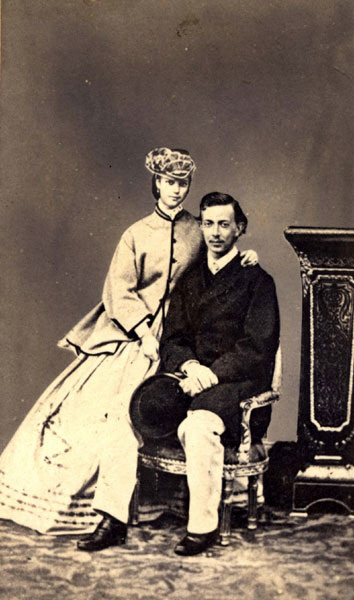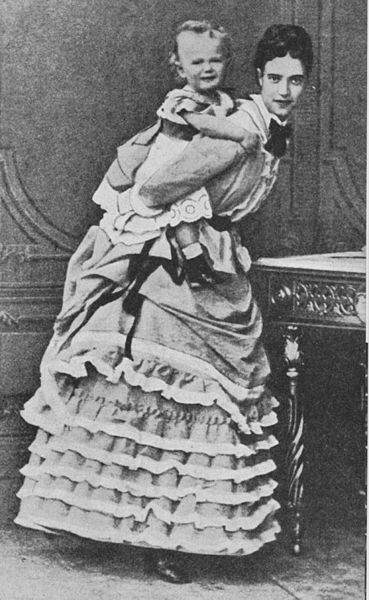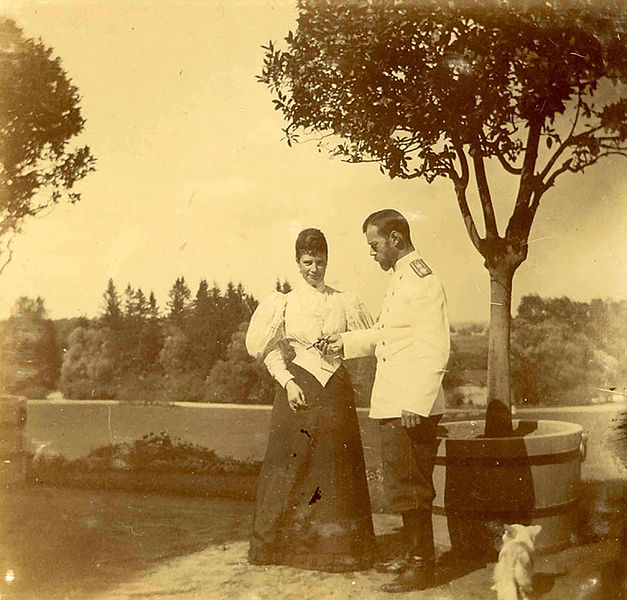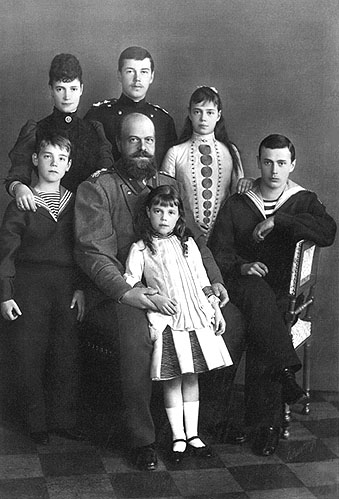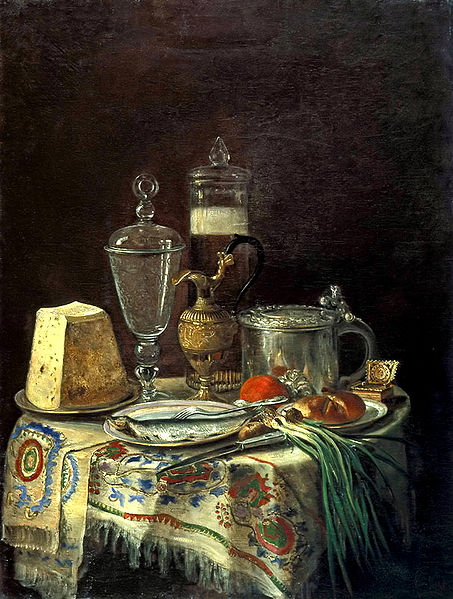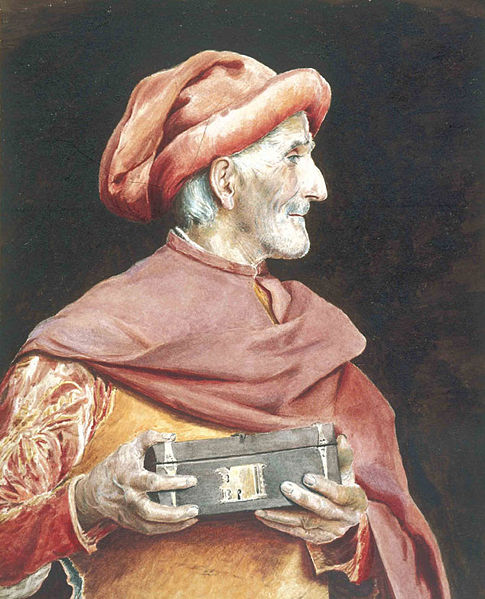<Back to Index>
- Physicist Karl Rudolf Koenig, 1832
- Poet William Cowper, 1731
- Empress Consort of All of Russias Maria Feodorovna, 1847
PAGE SPONSOR
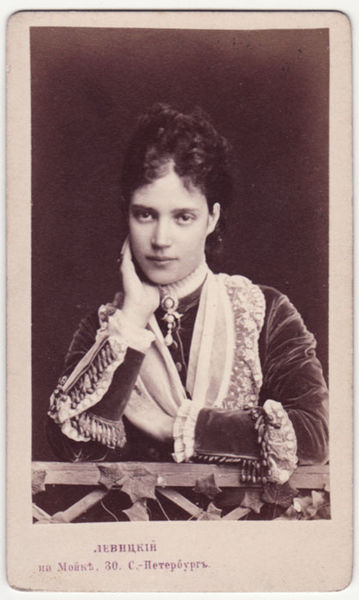
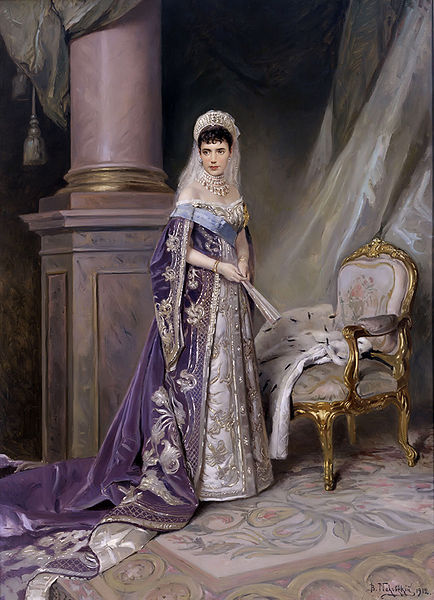
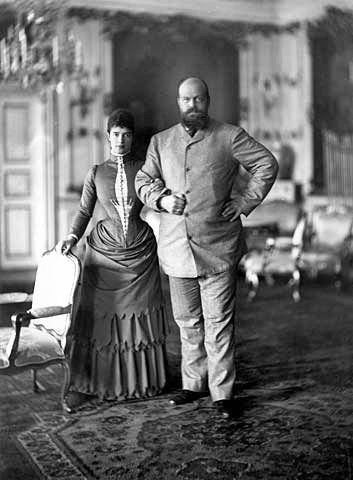
Maria Feodorovna (26 November 1847 – 13 October 1928), born Princess Dagmar of Schleswig - Holstein - Sonderburg - Glücksburg and later Princess Dagmar of Denmark, was Empress consort of Russia as spouse of Emperor Alexander III. She was the second daughter of King Christian IX of Denmark and Louise of Hesse-Cassel. Among her children was the last Russian monarch, Emperor Nicholas II, whom she outlived by ten years.
Princess Marie Sophie Fredrica/Frederikke Dagmar of Denmark was named after her kinswoman Marie Sophie Fredrica of Hesse - Kassel (1767 – 1852), Queen Dowager of Denmark. Dagmar's father soon became an heir to the throne of Denmark, largely due to his wife's succession rights as niece of King Christian VII. Born in Copenhagen as a daughter of a relatively impoverished princely cadet line, she was baptized into the Lutheran faith. Her father became King of Denmark in 1863 on the death of King Frederik VII. Due to the brilliant alliances of his children, he became known as the "Father-in-law of Europe." She was the sister-in-law of King Edward VII, the husband of her older sister Alexandra of Denmark. Most of her life, she was known as Maria Feodorovna (in Russian Мария Фёдоровна), the name which she took when converting to Orthodoxy immediately before her 1866 marriage to the future Tsar Alexander III. She was known within her family as Minnie.
Maria Feodorovna was the younger sister of Alexandra, Queen Consort of King Edward VII and mother of George V of the United Kingdom, which helps to explain the striking resemblance between Nicholas II and George V. Her older brother was King George I of Greece. Her eldest brother became King Frederik VIII. Her youngest sister was Thyra, Duchess of Cumberland.
During her upbringing, Dagmar, together with her sister Alexandra, was
given swimming lessons by the Swedish pioneer of swimming for women, Nancy Edberg; she would later welcome Edberg to Russia, where she came on royal scholarship to hold swimming lessons for women. The rise of Slavophile ideology in the Russian Empire led Alexander II of Russia to search for a bride for the heir apparent, Tsesarevich Nicholas Alexandrovich of Russia,
in countries other than the German states that had traditionally
provided consorts for the tsars. In 1864, Nicholas, or "Nixa" as he was
known in his family, went to Denmark where he was betrothed to Dagmar.
On 22 April 1865 he died from meningitis. His last wish was that Dagmar would marry his younger brother, the future Alexander III.
Dagmar was distraught after her young fiancé's death. She was so
heartbroken when she returned to her motherland that her relatives were
seriously worried about her health. She had already become emotionally
attached to Russia and often thought of the huge, remote country that
was to have been her home. The disaster had brought her very close to
"Nixa's" parents, and she received a letter from Alexander II in which
the Emperor attempted to console her. He told Dagmar in very
affectionate terms that he hoped she would still consider herself a
member of their family. In
June 1866, while on a visit to Copenhagen, the Tsarevich Alexander
asked Dagmar for her hand. They had been in her room looking over
photographs together. Dagmar left Copenhagen on 1 September 1866. Hans Christian Andersen was
among the crowd which flocked to the quay in order to see her off. The
writer remarked in his diary: "Yesterday, at the quay, while passing me
by, she stopped and took me by the hand. My eyes were full of tears.
What a poor child! Oh Lord, be kind and merciful to her! They say that
there is a brilliant court in Saint Petersburg and the tsar's family is
nice; still, she heads for an unfamiliar country, where people are
different and religion is different and where she will have none of her
former acquaintances by her side". Dagmar was warmly welcomed in Kronstadt by Alexander II of Russia and
all his family. She converted to Orthodoxy and became Grand Duchess
Maria Feodorovna of Russia. The lavish wedding took place on 9 November [O.S. 28 October] 1866 in the Imperial Chapel of the Winter Palace in St.Petersburg.
After the wedding night, Alexander wrote in his diary, "I took off my
slippers and my silver embroidered robe and felt the body of my beloved
next to mine... How I felt then, I do not wish to describe here.
Afterwards we talked for a long time." After the many wedding parties were over the newlyweds moved into the Anichkov Palace in
St.Petersburg where they were to live for the next 15 years, when they
were not taking extended holidays at their summer villa Livadia in the Crimea.
Maria
Feodorovna was pretty and popular. Early on she made it a priority to
learn the Russian language and to try to understand the Russian people.
She rarely interfered with politics, preferring to devote her time and
energies to her family, charities and the more social side of her
position. Her one exception was her militant anti-German sentiment due to the annexation of Danish territories by the newly created German Empire. On
the morning of 13 March 1881, Alexander II, aged sixty-two, was killed
by a bomb on the way back to the Winter Palace from a military parade.
In her diary, Maria later described how the wounded, still living Tsar
was taken to the palace: "His legs were crushed terribly and ripped
open to the knee; a bleeding mass, with half a boot on the right foot,
and only the sole of the foot remaining on the left." Alexander
II died a few hours later. Although the people were not enamoured of
the new Tsar, they adored Russia's new empress. As Maria's
contemporaries said of her: "She is truly an Empress." She herself was
not altogether pleased with her new status. In her diary she wrote,
"Our happiest and serenest times are now over. My peace and calm are
gone, for now I will only ever be able to worry about Sasha." Alexander and Maria were crowned at the Kremlin in
Moscow on 27 May 1883. Just before the coronation, a major conspiracy
had been uncovered, which cast a pall over the celebration.
Nevertheless over 8000 guests attended the splendid ceremony. Because
of the many threats against Maria and Alexander III, the head of the
security police, General Cherevin, shortly after the coronation urged the Tsar and his family to relocate to Gatchina Palace, a more secure location, 50 kilometres outside St.Petersburg. The huge palace had 900 rooms and was built by Catherine II.
The Romanovs heeded the advice. Maria and Alexander III lived at
Gatchina for 13 years, and it was here that their five surviving
children grew up. Under
heavy guard, Alexander III and Maria made periodic trips from Gatchina
to the capital to take part in official events. Maria longed for the
balls and gatherings in the Winter Palace. These also occurred at
Gatchina. Alexander used to enjoy joining in with the musicians,
although he would end up sending them off one by one. When that
happened, Maria knew the party was over. During
Alexander III's reign, the monarchy's opponents quickly disappeared
underground. A group of students had been planning to assassinate
Alexander III on the sixth anniversary of his father's death at the Peter and Paul Cathedral in
St.Petersburg. The plotters had stuffed hollowed-out books with
dynamite, which they intended to throw at the Tsar when he arrived at
the cathedral. However, the Russian secret police uncovered the plot
before it could be carried out. Five students were hanged; amongst them
was Aleksandr Ulyanov, older brother of Vladimir Lenin. When Maria's eldest sister Alexandra visited
Gatchina in July 1894, she was surprised to see how weak her
brother-in-law Alexander III had become. He seemed to have shrivelled.
Gone was the glow in his cheeks and his good cheer. At the time Marie
had long known that he was ill and did not have long left. She now
turned her attention to her eldest son, the future Nicholas II, for it was on him that both her personal future and the future of the dynasty now depended. Nicholas had long had his heart set on marrying Princess Alix of Hesse-Darmstadt.
Neither Alexander III nor Maria approved of the match. Nicholas summed
up the situation as follows: "I wish to move in one direction, and it
is clear that Mama wishes me to move in another - my dream is to one
day marry Alix." Maria
and Alexander found Alix shy and somewhat peculiar. They were also
concerned that the young Princess was not possessed of the right
character to be Empress of Russia. Nicholas's parents had known Alix as
a child and formed the impression that she was hysterical and
unbalanced. Reluctantly they both agreed for Nicholas and Alix to wed. On 1 November 1894, Alexander III died
aged just forty-nine at Livadia. In her diary Maria wrote, "I am
utterly heartbroken and despondent, but when I saw the blissful smile
and the peace in his face that came after, it gave me strength." For a time Maria was inconsolable. Her sister, Alexandra, and brother-in-law, the future Edward VII arrived in Russia a few days later. The Prince of Wales planned Alexander's funeral and also set a date for the new Tsar Nicholas II's wedding to Alix. Maria Feodorovna's grandson-in-law, Prince Felix Yusupov, noted that she had great influence in the Romanov family. Sergei Witte praised her tact and diplomatic skill. Nevertheless, she did not get along well with her daughter-in-law, Alexandra Feodorovna, probably holding her responsible for many of the woes that beset the family of her son Nicholas. Once the death of Alexander III had
receded, Maria again took a brighter view of the future. "Everything
will be all right," as she said. She had lived for twenty-eight years
in Russia, including thirteen as Empress, and thirty-four years of
widowhood still awaited her, the last ten in exile in her ancestral
land. At the end of November 1894, Maria moved into the Anichkov Palace in
St.Petersburg, where she remained until the revolution began.
Gradually, she was able to live and comport herself freely, and as time
passed she grew less fearful. As Dowager Empress, she was no longer a
political target for socialist and anarchist assassins. Empress Maria Fedorovna, the mistress of Langinkoski retreat, was also otherwise a known friend of Finland. During the first russification period, she tried to have her son Nicholas to stop russification actions and to recall the unpopular Governor General Bobrikov from
Finland to some other position in Russia itself. Also at occasion
later, the Dowager Empress showed her disappreciation towards certain
officialdom activities in Finland: when she travelled by her special
train from West through Finland to Petersburg, she made the orchestra
to play the March of Pori regiment (also known as March of Bonaparte) and the Finnish anthem 'Our Country', two items which at the time were under the explicit ban from Frans Albert Alexandrovich Seyn, the then russifying Governor General of Finland. Revolution came to Russia in March 1917. After meeting with her overthrown son, Nicholas II in Mogilev, Maria stayed for a while in Kiev, continuing her work for the Red Cross.
When it became too dangerous for her to remain, she set off for the
Crimea with a group of other refugee Romanovs. At the Black Sea, she
received reports that her sons, her daughter-in-law and her
grandchildren had been murdered. However, she rejected the report
publicly as rumour. On the day after the murder of the Tsar's family,
Maria received a messenger from Nicky, "a touching man" who told how
difficult was the life of her son's family in Ekaterinburg. "And nobody can help or liberate them - only God! My Lord save my poor, unlucky Nicky, help him in his hard ordeals!" In her diary she comforted herself: "I am sure they all got out of Russia and now the Bolsheviks are trying to hide the truth." She
firmly held on to this conviction until her death. The truth was too
painful for her to bear. Her letters to her son and his family have
since almost all been lost; but in one that survives, she wrote to
Nicholas: "You know that my thoughts and prayers never leave you. I
think of you day and night and sometimes feel so sick at heart that I
believe I cannot bear it any longer. But God is merciful. He will give
us strength for this terrible ordeal." Maria's daughter Olga
Alexandrovna commented further on the matter, "Yet I am sure that deep
in her heart my mother had steeled herself to accept the truth some
years before her death." Despite
the overthrow of the monarchy (1917), the Empress Maria at first
refused to leave Russia. Only in 1919, at the urging of her sister Alexandra, did she grudgingly depart, fleeing via the Crimea over the Black Sea to London. King George V sent the warship HMS Marlborough to retrieve his aunt. After a brief stay in the British base in Malta and later London, she returned to her native Denmark, choosing her former holiday villa Hvidøre near Copenhagen as
her new permanent home. Although Queen Alexandra never treated her
sister badly and they spent holidays together in a shared cottage in
Great Britain, Maria felt that she was now "number two". In exile in Copenhagen, Denmark,
there were many Russian émigrées. For them, Maria still
remained the Empress. People respected and highly valued her and often
asked her for help. The All-Russian Monarchial Assembly held in 1921
offered her to become the locum tenens of
the Russian throne. She declined the request - she would not like to
interfere in political games and gave the evasive answer, "Nobody saw
Nicky killed" and therefore there is a chance. She rendered financial
support to Nikolai Sokolov, the investigator who studied the circumstances of the death of the
Tsar's family. They did not meet - at the last moment, Grand Duchess
Olga sent a telegram to Paris requesting to cancel the appointment. It
would be too difficult for the old and sick woman to hear the terrible
story of her son and his family. In November 1925, Maria's favourite sister, Queen Alexandra,
died. For Maria that was the last loss that she could bear. "She was
ready to meet her Creator," wrote her son-in-law, Grand Duke Alexander
Mikhailovich, about Maria's last years. On 13 October 1928 at Hvidøre near Copenhagen, in a house she had once shared with her sister Queen Alexandra, Maria died at the age of 80. Following services in Copenhagen's Russian Orthodox Alexander Nevsky Church, the Empress was interred at Roskilde Cathedral. In 2005, Queen Margarethe II of Denmark and President Vladimir Putin of Russia and their respective governments agreed that the Empress's remains should be returned to Saint Petersburg in accordance with her wish to be interred next to her husband. A number of ceremonies took
place from 23 to 28 September 2006. The funeral service, attended by
high dignitaries, including the Crown Prince and Princess of Denmark
and Prince and Princess Michael of Kent, did not pass without some
turbulence. The crowd around the coffin was so great that a young
Danish diplomat fell into the grave before the coffin was interred. On 26 September 2006, a statue of Maria Feodorovna was unveiled near her favourite Cottage Palace in Peterhof. Following a service at Saint Isaac's Cathedral, she was interred next to her husband Alexander III in the Peter and Paul Cathedral on 28 September 2006, 140 years after her first arrival to Russia and almost 78 years after her death.
